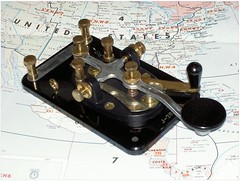Finally!
I have been known to procrastinate now and again. One thing on my to do list was uploading my log from Iraq (YI9MI) to Log Book of the World. When I initially tried to do it a few years back (my operation was 2007-2008), I had difficulties getting a certificate despite having the correct paperwork from the Iraqi government approving my operation.
Now that I am on my Winter Break, I decided to re-engage and was met with extraordinary help by ARRL’s Norm Fusaro, W3IZ (aka Mr. Log of The World). I emailed him my paperwork and he immediately turned around and emailed me back my certificate. Huzzah! But not quite yet….
I tried to upload my log, but none of the entries would parse. 🙁
At the time of my Iraq operation, I was using HRD for my logging and had an HRD generated .adi file. I decided to load that file into fldigi and then export it back out as an .adif – not sure if that was the trick, but the log parsed! Hazzah!
Hopefully I delivered early Christmas presents to any individuals out there who were waiting for a YI entity for an award. I am so relieved to finally get that log uploaded and into LoTW.
Every now and again I still get a QSL card to confirm. I have a nice hard copy of the log printed out which allows me to confirm the contact and record that I am sending out the confirmation QSL card.
If you think I still owe you a YI9MI confirmation either by QSL card or LoTW – please let me know.




 I have devoted a significant amount of time to plow through QSL cards for my YI9MI operation in Iraq last year. The highlight was getting a few cards with actual valid CW contacts. The hard part was sending QSL cards back to folks who had contacts with the CW
I have devoted a significant amount of time to plow through QSL cards for my YI9MI operation in Iraq last year. The highlight was getting a few cards with actual valid CW contacts. The hard part was sending QSL cards back to folks who had contacts with the CW  The title of this post is a little misleading. As I mentioned before, I am attending the Army’s Command & General Staff College (CGSC) here at Fort Leavenworth, Kansas (… I bet you thought I was out here in Kansas just for the nice weather). One of the new requirements we have as students at is to egage in “Strategic Communication”. Wikipedia defines strategic communications as: communicating a concept, a process, or data that satisfies a long term strategic goal of an organization by allowing facilitation of advanced planning. Our requirements as students to engage in strategic communication does not exactly line up with that definition, but I think it gives you an idea of where the Army is headed. The bottom line is the Army wants to develop officers who are familiar and comfortable in dealing with the media in order to get the Army’s “message” out. In the past the military has been traditionally media shy (understatement), either making heavy use of the “no comment” or deferring to our public relations officers. No more. The Army recognizes this is the new media age and those that get their story out first, in a clear and understandable fashion are likely to better garner public support… both domestic and international. Okay… so back to school. My requirements, as related to strategic communications, are to: (1) participate in an actual media interview (television, print, or radio), (2) speak to a community group, school, or other organized gathering of citizens, (3) write professionally by submitting a letter to the editor, Op-Ed piece, or article for publication, and (4) participate in a reputable blog about their military service.
The title of this post is a little misleading. As I mentioned before, I am attending the Army’s Command & General Staff College (CGSC) here at Fort Leavenworth, Kansas (… I bet you thought I was out here in Kansas just for the nice weather). One of the new requirements we have as students at is to egage in “Strategic Communication”. Wikipedia defines strategic communications as: communicating a concept, a process, or data that satisfies a long term strategic goal of an organization by allowing facilitation of advanced planning. Our requirements as students to engage in strategic communication does not exactly line up with that definition, but I think it gives you an idea of where the Army is headed. The bottom line is the Army wants to develop officers who are familiar and comfortable in dealing with the media in order to get the Army’s “message” out. In the past the military has been traditionally media shy (understatement), either making heavy use of the “no comment” or deferring to our public relations officers. No more. The Army recognizes this is the new media age and those that get their story out first, in a clear and understandable fashion are likely to better garner public support… both domestic and international. Okay… so back to school. My requirements, as related to strategic communications, are to: (1) participate in an actual media interview (television, print, or radio), (2) speak to a community group, school, or other organized gathering of citizens, (3) write professionally by submitting a letter to the editor, Op-Ed piece, or article for publication, and (4) participate in a reputable blog about their military service. 
